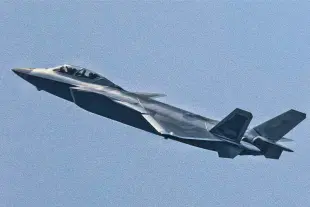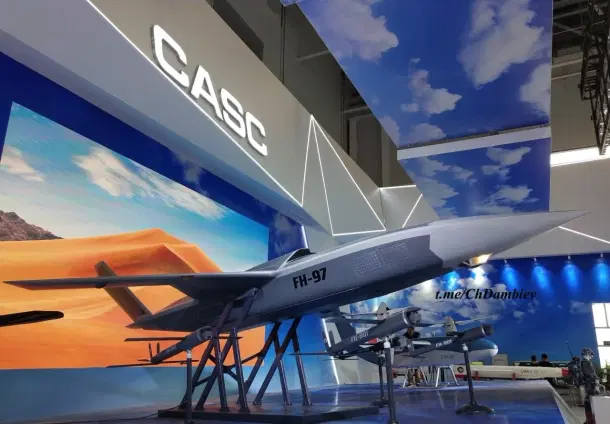Defence
With J-20S, China Is Once Again Taking Lead In Redefining Air Combat
Prakhar Gupta
Jul 30, 2025, 01:20 PM | Updated 02:23 PM IST
Save & read from anywhere!
Bookmark stories for easy access on any device or the Swarajya app.


A flurry of new images showing the twin-seat variant of China’s J-20 stealth fighter, unofficially dubbed the J-20S, has reignited debate about Beijing’s next leap in air combat. The photos, which appear to show multiple airframes, with at least one bearing a serial number linked to an operational People’s Liberation Army Air Force (PLAAF) unit, suggest this is no longer just a prototype. It may be entering frontline service.
For years, there has been speculation about the role of this two-seat J-20. No Western air force operates a comparable aircraft, which has prompted questions about China’s intentions. Initial theories suggested possible roles in electronic warfare or airborne command and control. But a more strategic purpose is now coming into focus, one that aligns with how major powers are reimagining air combat.
There is growing consensus among China watchers that the J-20S is intended to support manned-unmanned teaming. This approach involves piloted fighters operating alongside autonomous drones, or loyal wingmen, that can scout ahead, jam enemy radars, gather intelligence, or deliver weapons. In such a concept, the second seat is not for instruction or redundancy but for command and control.
The second seat would be highly relevant for a mission controller directing unmanned aircraft and managing the overall tactical picture, a concept similar to that being explored for American two-seat fighters like the F-15EX, which feature wide-area cockpit displays optimised for such roles.
China has already been exploring this model using modified J-16 fighters. With the J-20S, it appears to be shifting the concept onto a frontline stealth platform, giving a second crew member the job of managing unmanned systems in real time. This allows the J-20 to serve not only as a strike or air superiority asset but potentially as a command node for drone operations in contested airspace.
The United States is moving fast with its Collaborative Combat Aircraft (CCA) programme. India, too, is developing its own loyal wingman initiative. But with twin-seat J-20s now ready to enter service, China seems to have gained a major lead.
Loyal Wingman
Loyal wingman systems are unmanned combat aircraft designed to operate alongside piloted fighters, flying in coordination to absorb risk, extend sensor reach, and conduct strikes under varying levels of human supervision.
These are not traditional UAVs operated from remote ground stations. They are launched into battle as part of a tactical formation, with the fighter pilot or a second crew member, as in the J-20S, managing and coordinating their roles in real time.
The idea is to turn each crewed aircraft into a command node, supported by drones that act as sensors, jammers, decoys, or missile carriers. These unmanned systems do not merely expand the combat reach of the pilot. They change the tactical equation altogether, introducing mass, confusion, and adaptability into the battle-space.
Getting this model to work requires solving two hard problems. One is reliable real-time data links in contested environments. The other is a level of autonomy in the drones that allows them to carry out delegated tasks with minimal micromanagement.
The potential payoff is immense. A single fighter could direct multiple drones, striking targets deep inside enemy territory without putting human lives at risk.
It is a concept that offers numerical advantage, survivability, and faster decision-making, all at a fraction of the cost of building more piloted jets.
The US is pursuing a similar model through its Collaborative Combat Aircraft (CCA) programme, which will see a future sixth-generation fighter, known as NGAD, operate alongside a fleet of AI-enabled drones.
One of the main testbeds for this concept is the XQ-58A Valkyrie, a stealthy, low-cost unmanned jet developed by Kratos. The Valkyrie has already demonstrated semi-autonomous flight, payload delivery, and even the ability to release its own smaller drones mid-flight. The broader goal is to build a family of attritable drones that can scout, jam, or strike, all under the control of a crewed aircraft operating in or near contested airspace.
Australia, working with Boeing, has developed the MQ-28 Ghost Bat, the first loyal wingman prototype to fly in partnership with a Western air force. The Ghost Bat is designed to operate either autonomously or in coordination with crewed aircraft like the F/A-18 or F-35, using onboard AI to adapt its mission profile in flight. The programme has already completed multiple test flights.
India, meanwhile, is advancing its Combat Air Teaming System (CATS), being developed by HAL and the Aeronautical Development Agency. Under this concept, fighters like the Tejas Mk1A or the upcoming AMCA will direct a swarm of autonomous drones, such as the CATS Warrior, designed for deep-strike and SEAD (Suppression of Enemy Air Defences) missions.
While still at the prototype stage, the concept has begun moving from paper to hardware. At Aero India 2021, HAL showcased a scaled-down mock-up of the CATS Warrior for the first time. By Aero India 2025, a full-scale prototype was on display. In January 2025, HAL successfully completed the engine ground run of the demonstrator, with taxi trials and the first flight of the platform expected by the end of the year.
China Takes a Lead
A new video circulating online last week showed a tailless Chinese drone flying in formation with a turboprop aircraft, another strong signal that Beijing’s loyal wingman programmes are progressing rapidly from testbeds to operational maturity.
The drone, featuring a diamond-shaped delta wing and flying alongside what appears to be a Y-8 or Y-9 transport aircraft, is longer than most known loyal wingman systems. Its design, while reminiscent of next-generation stealth fighters like the Chengdu J-36 or Shenyang J-50, appears smaller and optimised for a supporting role.
This follows a steady stream of disclosures around China’s manned-unmanned teaming efforts. The stealthy GJ-11 combat drone remains a high-end option, but Beijing has also been developing a range of lower-cost, autonomous systems meant to operate in formation with crewed aircraft like the J-20.
The FH-97A, unveiled at the 2024 Zhuhai Airshow, is China’s most publicised loyal wingman drone to date, with a design visibly influenced by Western platforms like the XQ-58 Valkyrie. The drone, which can carry up to eight air-to-air missiles or loitering munitions, is intended for “confrontational, high-intensity and long-duration combat,” China had said at the time. But despite its high-profile rollout, there is no public evidence it has flown yet, let alone entered service with the PLA Air Force.

A more serious contender might be the Sky Hawk, a stealth drone that has been in development for years. It has flown before, and its makers say it can work alongside crewed jets, but details about its use in the MUM-T role remain scarce.
China has been working on improving its MUM-T capabilities with the J-16 fighter. In December 2023, reports emerged of a joint exercise involving a J-16 and a GJ-2 UAV in the PLA’s Western Theatre Command, which is responsible for the border with India.
The aircraft reportedly operated alongside radar and surface-to-air missile units, with the GJ-2 transmitting target coordinates for an air-to-ground strike. These were relayed to a base control tower, which then instructed the J-16s to carry out the attack based on the uploaded data. It remains unclear whether the UAVs sent information directly to the J-16s or whether the fighters exercised any control over the drones.
The MUM-T capability demonstrated in the exercise was basic and fell short of representing any significant breakthrough. Even so, the PLA framed the exercise as a milestone in breaking down barriers between manned and unmanned operations. Such exercises are likely to become more frequent with the operationalisation of the J-20S.
China also appears to have begun testing an artificial intelligence-enabled “computer brain” aboard its J-16 Flanker fighter, in a move that mirrors efforts under the US Air Force’s Skyborg programme, which is developing an AI system to autonomously operate networked loyal wingman-type drones.
But China does not necessarily need to wait for such a high level of autonomy to mature before fielding loyal wingman-type drones alongside the J-20S.
A more immediate and operationally viable concept would involve a semi-autonomous control interface within the cockpit of a manned combat aircraft, allowing the pilot to issue commands to loyal wingmen within visual or radio line of sight.
While this falls short of full autonomy, it allows for meaningful manned-unmanned teaming in high-threat environments and enables loyal wingman drones to perform decoy, reconnaissance, or suppression-of-defence missions without placing pilots at risk.
It is this model of deployment of loyal wingman drones that the PLA Air Force appears to be moving toward with the twin-seat J-20.
Prakhar Gupta is a senior editor at Swarajya. He tweets @prakharkgupta.





